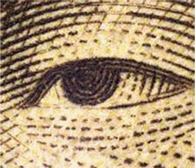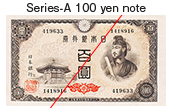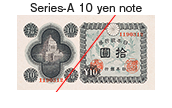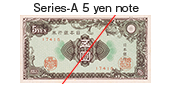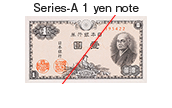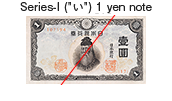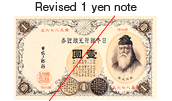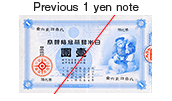Banknotes in Use but No Longer Issued
Display of pre-Series F banknotes. These are no longer issued by the Bank of Japan, but the following 21 types are.
Issued in 2004 (Series-E)
 Series-E 10,000 yen
Series-E 10,000 yen
 Series-E 5,000 yen
Series-E 5,000 yen
 Series-E 1,000 yen
Series-E 1,000 yen
Issued in 1984 (Series-D)
Issued in 1957-1969 (Series-C)
Issued in 1950-1953(Series-B)
Issued in 1946 (Series-A)
Issued before 1943
Series-E 10,000 yen note

| Front side | A portrait of Yukichi Fukuzawa, a Meiji era philosopher and founder of Keio University. |
|---|---|
| Reverse side | A drawing of the hoo (Chinese phoenix) in the Hall of the Phoenix, Byodoin temple. |
| Size | 76mm height×160mm width |
| Date of first issue | Nov. 1, 2004 |
Interesting Information
Did you know that there are two types of 10,000 yen banknote featuring Yukichi Fukuzawa?

There are two types of banknotes carrying the portrait of Yukichi Fukuzawa; one is the Series-E 10,000 yen note that is currently being issued, and the other is the Series-D 10,000 yen note that was issued in 1984 (Showa 59).
The Series-E 10,000 yen note (figure on the right) has a hologram on the front, and an image of a Chinese phoenix on the reverse side.
The Series-D 10,000 yen note (figure on the left) does not have a hologram on the front, and has two Japanese pheasants on the reverse side.
Both series of banknotes are acceptable currency at present.
Series-E 5,000 yen note

| Front side | A portrait of Ichiyo Higuchi, a Meiji era writer and poet. |
|---|---|
| Reverse side | “Kakitsubata Flowers”, from a folding screen by Korin Ogata. |
| Size | 76mm height × 156mm width |
| Date of first issue | Nov. 1, 2004 |
Series-E 1,000 yen note

| Front side | A portrait of Hideyo Noguchi, a bacteriologist who devoted himself to yellow fever research. |
|---|---|
| Reverse side | A drawing of Mt. Fuji and cherry blossoms. |
| Size | 76mm height × 150mm width |
| Date of first issue | Nov. 1, 2004 |
Series-D 10,000 yen note

| Front side | Yukichi Fukuzawa |
|---|---|
| Reverse side | Two Japanese pheasants |
| Size | 76mm height×160mm width |
| Date of first issue | Serial number in black : Nov. 1, 1984 Serial number in brown : Dec. 1, 1993 |
| Issue suspended | Apr. 2, 2007 |
Series-D 5,000 yen note

| Front side | Inazo Nitobe |
|---|---|
| Reverse side | Mt. Fuji |
| Size | 76mm height×155mm width |
| Date of first issue | Serial number in black : Nov. 1, 1984 Serial number in brown : Dec. 1, 1993 |
| Issue suspended | Apr. 2, 2007 |
Series-D 1,000 yen note

| Front side | Soseki Natsume |
|---|---|
| Reverse side | Two Japanese cranes |
| Size | 76mm height×150mm width |
| Date of first issue | Serial number in black : Nov. 1, 1984 Serial number in blue : Nov 1, 1990 Serial number in brown : Dec. 1, 1993 Serial number in dark green : Apr. 3, 2000 |
| Issue suspended | Apr. 2, 2007 |
Series-C 10,000 yen note

| Front side | Prince Shotoku |
|---|---|
| Reverse side | Guilloche |
| Size | 84mm height×174mm width |
| Date of first issue | Dec. 1, 1958 |
| Issue suspended | Jan. 4, 1986 |
Series-C 5,000 yen note

| Front side | Prince Shotoku |
|---|---|
| Reverse side | Building of Bank of Japan |
| Size | 80mm height×169mm width |
| Date of first issue | Oct. 1, 1957 |
| Issue suspended | Jan. 4, 1986 |
Series-C 1,000 yen note

| Front side | Hirobumi Ito |
|---|---|
| Reverse side | Building of Bank of Japan |
| Size | 76mm height×164mm width |
| Date of first issue | Serial number in black : Nov. 1, 1963 Serial number in blue : Jul.1,1976 |
| Issue suspended | Jan. 4, 1986 |
Series-C 500 yen note

| Front side | Tomomi Iwakura |
|---|---|
| Reverse side | Mt. Fuji |
| Size | 72mm height×159mm width |
| Date of first issue | Nov. 1, 1969 |
| Issue suspended | Apr. 1, 1994 |

| Front side | Prince Shotoku |
|---|---|
| Reverse side | Horyuji Yumedono |
| Size | 76mm height ×164mm width |
| Date of first issue | Jan. 7, 1950 |
| Issue suspended | Jan. 4, 1965 |

| Front side | Tomomi Iwakura |
|---|---|
| Reverse side | Mt. Fuji |
| Size | 76mm height ×156mm width |
| Date of first issue | Apr. 2, 1951 |
| Issue suspended | Jan. 4, 1971 |

| Front side | Taisuke Itagaki |
|---|---|
| Reverse side | National Diet Building |
| Size | 76mm height ×148mm width |
| Date of first issue | Dec. 1, 1953 |
| Issue suspended | Aug. 1, 1974 |

| Front side | Korekiyo Takahashi |
|---|---|
| Reverse side | Building of Bank of Japan |
| Size | 68mm height ×144mm width |
| Date of first issue | Dec. 1, 1951 |
| Issue suspended | Oct. 1, 1958 |

| Front side | Prince Shotoku |
|---|---|
| Reverse side | Horyuji Temple |
| Size | 93mm height ×162mm width |
| Date of first issue | Feb. 25, 1946 |
| Issue suspended | Jun. 5, 1956 |
Banknotes with no red mark below the central “百圓” text on the front or with red on the back are invalid.

| Front side | National Diet Building |
|---|---|
| Reverse side | Decorative knot |
| Size | 76mm height ×140mm width |
| Date of first issue | Feb. 25, 1946 |
| Issue suspended | Apr. 1, 1955 |

| Front side | Guilloche |
|---|---|
| Reverse side | Guilloche |
| Size | 68mm height ×132mm width |
| Date of first issue | Mar. 5, 1946 |
| Issue suspended | Apr. 1, 1955 |

| Front side | Sontoku Ninomiya |
|---|---|
| Reverse side | Guilloche |
| Size | 68mm height ×124mm width |
| Date of first issue | Mar. 19, 1946 |
| Issue suspended | Oct. 1, 1958 |

| Front side | Sukune Takenouchi |
|---|---|
| Reverse side | Ube shrine |
| Size | 70mm height ×122mm width |
| Date of first issue | Dec.15, 1943 |
| Issue suspended | Oct. 1, 1958 |

| Front side | Sukune Takenouchi |
|---|---|
| Reverse side | 1 yen silver coin |
| Size | 85mm height ×145mm width |
| Date of first issue | Serial number in Chinese characters : May 1, 1889 Serial number in alphabets and Arabic numerals : Aug. 15, 1916 |
| Issue suspended | Oct. 1, 1958 |

| Front side | Daikokuten (Mahakala) |
|---|---|
| Reverse side | Guilloche |
| Size | 78mm height ×135mm width |
| Date of first issue | Sep. 8, 1885 |
| Issue suspended | Oct. 1, 1958 |
Anti-counterfeiting measures (Series-E notes)
Intaglio printing
Notes are printed with ink that rises higher than the ink on older notes, giving them a textured feeling when touched.



Tactile marks
In place of watermarking, tactile marks by intaglio printing with a textured feeling are employed to help the visually handicapped distinguish different notes with their fingers.Identifying marks are shaped differently for each type of note in order to make it easier to differentiate between the different notes.



Watermark
Watermarking is a technique to prevent counterfeiting by producing variations in the thickness of the paper. The watermark has sharp and spatial gradation in its image.
There are watermarks of Yukichi Fukuzawa, Ichiyo Higuchi, Hideyo Noguchi, and the Shurei Gate in Okinawa; the same portraits and landscape as the ones found on the front of the notes.



Watermark-bar-pattern
Watermarks in bar patterns are embedded in the paper. When seen against the light, the Series-E 10,000 yen note has 3 bars, the Series-E 5,000 yen note has 2 bars, and the Series-E 1,000 yen note has 1 bar.



Hologram
When seen from different angles, the characters for the denomination “10000”, a design of “日” from “日本銀行” meaning the Bank of Japan, and the image of a cherry tree appear.


Latent images
When tilting a note, the denomination “10000”, “5000” and “2000” appears on the front side, and “NIPPON” appears on the reverse side.



Pearl patterns as latent images
When the note is tilted, depending on the angle, the characters “千円” or the denomination “1000” produced by pearl printing appear as latent images in the bar on the bottom left of the note.

Pearl ink
Not visible from the front, but when tilting a note, a pink pattern emerges at the center of either end of the note.



Microprinting
“NIPPONGINKO” is printed in microscript that cannot be easily reproduced on color copy machines.
The letters can be discerned when magnified using a tool such as a loupe (magnifying glass).



Luminescent ink
When ultraviolet light is shone on a note, the seal of the Governor of the Bank of Japan on the front side, and part of the background pattern on either side, become luminous.



Anti-counterfeiting measures (Series-D notes)
Watermark
Watermarks are created by producing variations in the thickness of the paper, and can be either light or shaded. They are combined to pattern banknotes elaborately.
Watermarks also include tactile marks to help the visually impaired people distinguish different denominations.
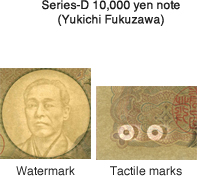
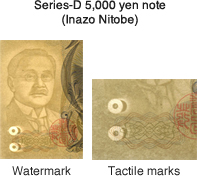
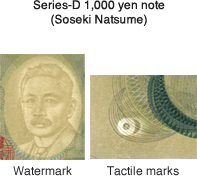
Intaglio printing
Image designs of the values and portraits on banknotes are thickly printed to give a notable texture.
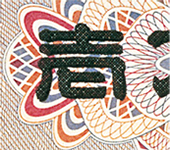
Ultrafine-line printing
Banknote designs are drawn with extremely fine lines. Such fine lines can hardly be replicated by color copy machines, or by ordinary printing equipment or similar devices.
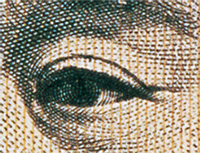
Luminescent ink
Banknotes with serial numbers in brown or dark green have a seal on the front side that glows under ultraviolet light.
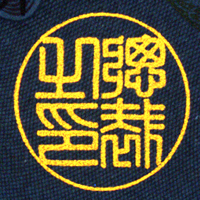
Microprinting
Banknotes with serial numbers in brown or dark green have the words “NIPPON GINKO” printed in small characters that can hardly be reproduced by color copy machines or similar devices.

Anti-counterfeiting measures (Series-C notes)
Watermark
Watermarks are created by producing variations in the thickness of the paper, and can be either light or shaded. They are combined to pattern banknotes elaborately.
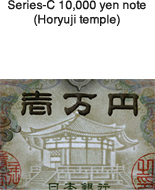
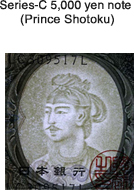
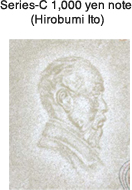
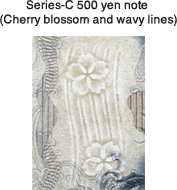
Intaglio printing
Image designs of the values and portraits on banknotes are thickly printed to give a notable texture.
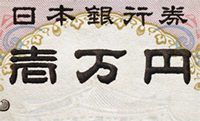
Ultrafine-line printing
Banknote designs are drawn with extremely fine lines. Such fine lines can hardly be replicated by color copy machines, or by ordinary printing equipment or similar devices.
